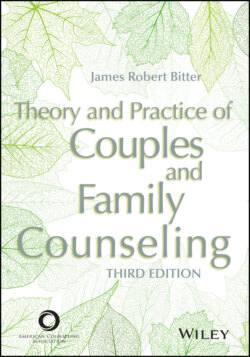Читать книгу Theory and Practice of Couples and Family Counseling - James Robert Bitter - Страница 80
Consider Collaborative Practice
ОглавлениеThe different approaches we will study in this book will present a wide range of therapeutic relational stances. Some will be exploratory in nature; others will be nurturing. Some will see the therapist as a coach, and others will approach family process as a conductor or a director. Still others will engage families in play. The distinctive styles of the masters of family therapy can be both magical and entertaining. Although it is important for each person to find and develop an individualized style, professional styles will change many times over the course of a career. Even the most innovative masters of therapy tended to approach their first family sessions carefully, allowing themselves time to observe and learn. I think this is a good way for most new practitioners to start.
Enter into your first family sessions from a position of respect. Let the family members you meet instruct you about their lives together. Start with interest, friendliness, and observation, the tools of an explorer. Do not rush the process of change. Even if you are limited to only one session lasting 1 hour, spend 45 minutes getting to know the family and its members. Consider the possibility that the family really does know what it needs and that its members can share in the process of setting goals for your work together. Consider the possibility that family members have many, if not all, of the resources they need to handle the challenges they face. Inviting families to be partners in the experience of counseling increases safety, reduces resistance, and leads to empowerment.
From such a foundation of respect, it is possible over time to integrate other skills, techniques, and interventions. It is not uncommon for even very experienced family practitioners to borrow skills and styles from one another. When I first started, I copied people I thought were effective, often using the very words and actions I had seen them use with their families. Some of the things I borrowed worked well for me too, and I made them part of my own style. Some things did not work so well, and I eventually let them go. Developing your own style involves trying things out, occasionally trusting your intuition, and experimenting with interventions. Innovation seeks what is fresh and lively, and its effectiveness is supported by the respectful connections we form with our clients.
If you have no other way to begin, consider saying, “I would like to get to know a little bit about each of you. What would be important for me to know?” Later you might also ask, “What did each of you hope would happen in our work together?” Such a start focuses the process on engagement and collaboration. It begins with an exploration of people and relationships and highlights the wishes and hopes that are often hidden in complaints and problems. It also tends to generate new information and allows family members to consider different perspectives. A collaborative relationship with clients may include the feedback of families as part of one’s own supervision. In the last 5 minutes of a session, I often ask families about what has worked for them: “How did this session go for you today? What was helpful? What is still missing for you?”
No matter how directive family practitioners have been during their careers, many of them become increasingly collaborative as they age (Aponte, 1994; Hoffman, 2002; S. Minuchin & Zeig, 2005a; Selvini, 1988). They become more patient in their approach. Their timing is more precise, and interventions seem to arrive in a style that is more easily received. Their work extends the capacity for joining throughout the session. If you want an effective process with which to get started, a collaborative stance will serve you well.
